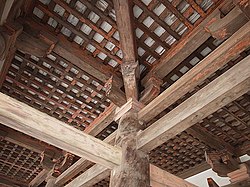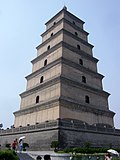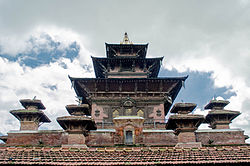Pagoda
A pagoda is any kind of tower with multiple eaves. They are common in eastern and southeastern Asia. Most pagodas are built for religious purposes. Most are usually Buddhist temples, while some are also used as Taoist temples and Muslim mosques and Gongbeis.[1][2]
These were first built during the 3rd century BC.[3] This kind of architecture has spread across Asia, taking on many differences as details specific to different regions are made a part of the overall design.[4] Stupas were used to house Buddhist relics.[3] Later, the architecture of Chinese towers and Chinese pavilions blended into pagoda architecture. This eventually spread to Southeast Asia. The pagoda's original purpose was to house relics and sacred writings.[5][6]
Pagoda Media
Kek Lok Si pagoda tiers labelled with their architectural styles
The Lingxiao Pagoda of Zhengding, Hebei, built in 1045 AD during the Song dynasty, with little change in later renovations
The Xumi Pagoda, built in 636 AD during the Tang dynasty.
Floor-support structure in a corner of the Horyuji temple.
The 40-metre-tall (130 ft) Songyue Pagoda of 523 AD, the oldest extant stone pagoda in China
The brick-constructed Giant Wild Goose Pagoda, built by 652 and rebuilt in 704, during the Tang dynasty.
Jade Buddha Temple in Shanghai follows the Song dynasty multi-courtyard design, and does not feature a pagoda. The main hall is at the center.
Taleju Temple, a 16th-century temple in Kathmandu Durbar Square
Changu Narayan Temple, Bhaktapur, Nepal
Ancient Chinese model of two residential towers, made of earthenware during the Han dynasty, 2nd century BC to 2nd century AD, excavated by archaeologists in 1993.
References
- ↑ Brill Publishers. "PAGODA". Brill.com. Retrieved 11 December 2023.
- ↑ The Columbia Encyclopedia, Sixth Edition. Columbia University Press.
- ↑ 3.0 3.1 Pagoda. Encyclopædia Britannica
- ↑ The Evolution of Indian Stupa Architecture in East Asia. Eric Stratton. New Delhi, Vedams, 2002, viii, ISBN 81-7936-006-7
- ↑ A World History of Architecture. Michael W. Fazio, Marian Moffett, Lawrence Wodehouse. Published 2003. McGraw-Hill Professional. ISBN 0-07-141751-6.
- ↑ The Impact of Buddhism on Chinese Material Culture. John Kieschnick. Published 2003. Princeton University Press. ISBN 0-691-09676-7.
Other websites
![]() Media related to Pagodas at Wikimedia Commons
Media related to Pagodas at Wikimedia Commons
- Japanese Architecture and Art Net Users System (JAANUS), tasoutou 多層塔











